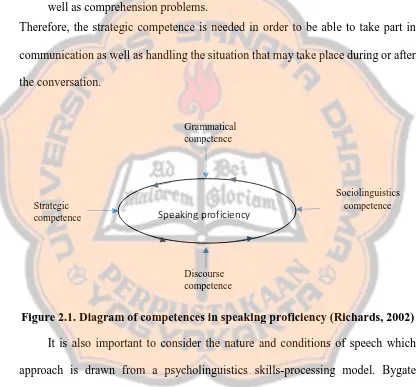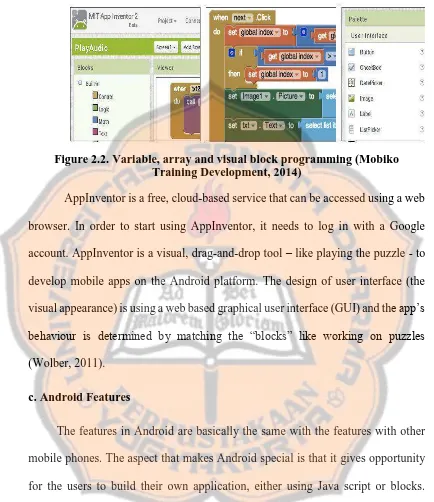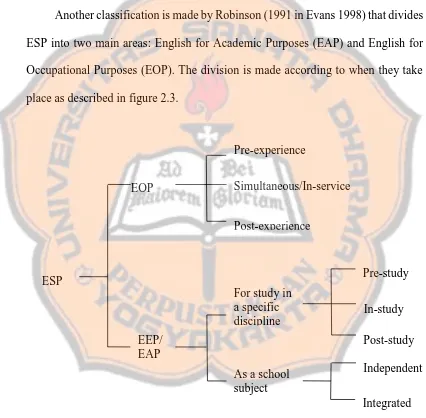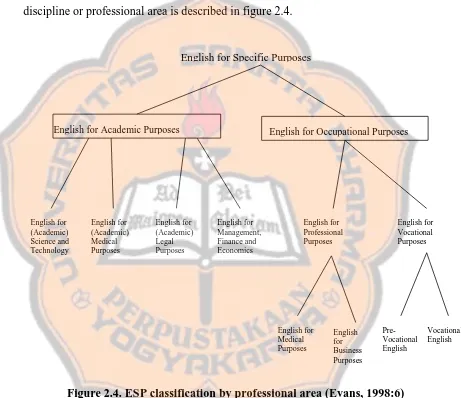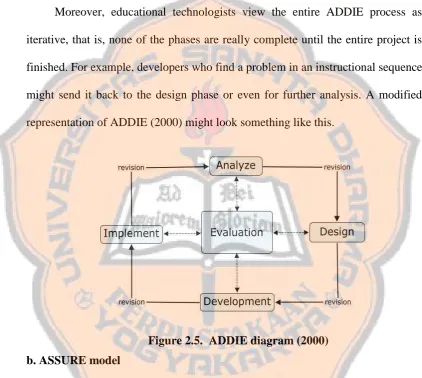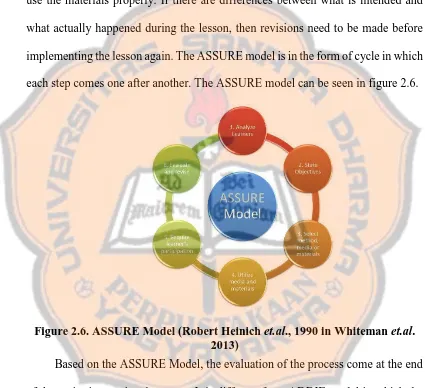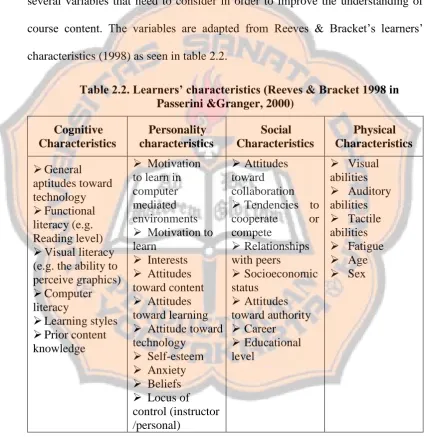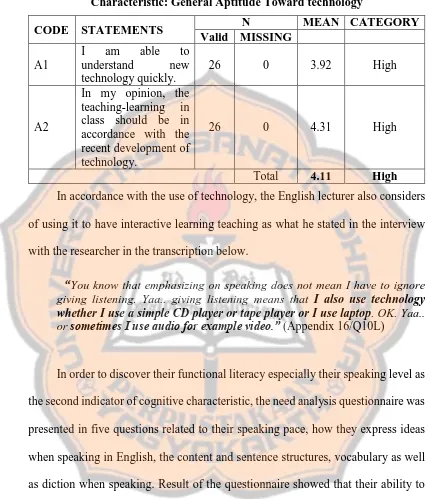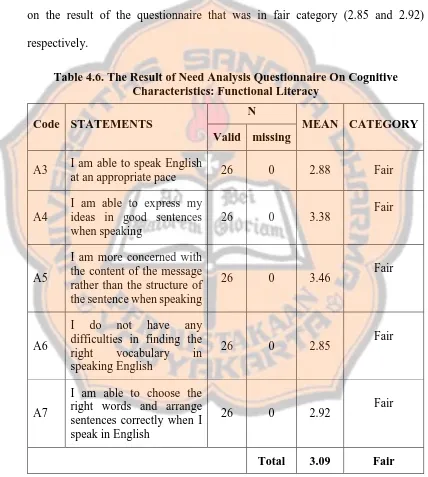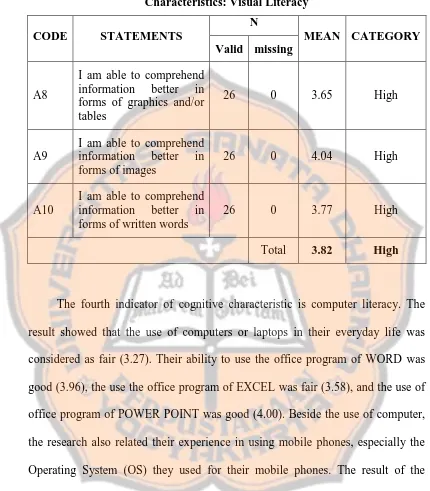xvii ABSTRACT
Harmanto, Margaretha Dharmayanti. 2016. “SPINE” (Speak English for Professional Nurses) Android Application to Learn Speaking English for Nursing Students. Yogyakarta: The Graduate Program in English Language Studies, Sanata Dharma University.
Speaking skill is one of the main focuses that nursing students need to gain in learning English because they need it to communicate with patients during intervention. Nowadays, mobile devices are also used as a medium of learning known as Mobile Assisted Language Learning (MALL) to promote learning anywhere, any time. This study aims to develop an Android application which is intended to help the nursing students to learn speaking English. There are two research questions in this study, the first is what the Android application to help the nursing students to learn speaking English looks like and the second research question is how the Android application is acceptable to the users.
This study used Research and Development (R&D) method proposed by Borg and Gall (1983) which was combined with the Hybrid instructional model developed by Passerini and Granger (2000). There were five stages in the Hybrid model namely analysis, design, development, evaluation and delivery. The data gathered were in forms of quantitative and qualitative data. The instruments used to obtain the data were classroom observation, questionnaires and interviews. The quantitative data was obtained from the questionnaires, while the qualitative data was from the result of open-ended questions in the questionnaire, interviews and classroom observation. Those instruments were used to answer the research questions. The research setting was STIKES Wira Husada Yogyakarta and the participants were the nursing students batch 2014.
The result of the study is an iconic model of Android application named SPINE which stands for Speak English for Professional Nurses. There are five topics in the application, which were chosen based on the syllabus. Each topic consists of five sub-topics namely pronunciation, listen and repeat, language focus, conversation and quiz. The second research question was answered based on the result of questionnaire in the implementation stage which measured the users’ perception about navigation pane, screen design, information presentation, media integration, and overall functionality of the application. The result shows that navigation pane is acceptable, the screen design is acceptable, the information presentation is acceptable, the media integration is acceptable, and the overall functionality is acceptable. Based on the total mean score, the application is also efficient and acceptable for the users (4.1) out of the maximal score (5.00).
In conclusion, SPINE application is also efficient and acceptable for the users in terms of its navigation pane, screen design information presentation, media integration, and overall functionality.
xviii ABSTRAK
Harmanto, Margaretha Dharmayanti. 2016. “SPINE” (Speak English for Professional Nurses) Android Application to Learn Speaking English for Nursing Students. Yogyakarta: The Graduate Program in English Language Studies, Sanata Dharma University.
Ketrampilan berbicara merupakan salah satu fokus utama pembelajaran Bahasa Inggris bagi mahasiswa keperawata karena ketrampilan tersebut diperlukan oleh mereka untuk berkomunikasi dengan pasien ketika sedang melaksanakan tugas keperawatan. Saat ini, handphone juga dipergunakan sebagai media pembelajaran yang dikenal dengan sebutan Mobile Assisted Language Learning (MALL) untuk menunjang proses pembelajaran di mana saja, kapan saja. Penelitian ini bertujuan untuk mengembangkan aplikasi Android yang dapat membantu mahasiswa keperawatan untuk belajar berbicara dalam Bahasa Inggris. Terdapat dua pokok permasalahan dalam penelitian ini, yang pertama, seperti apakah aplikasi Android untuk membantu mahasiswa keperawatan belajar berbicara Bahasa Inggris, dan kedua tentang bagaimana aplikasi Android ini dapat diterima oleh pengguna untuk membantu mereka belajar berbicara Bahasa Inggris.
Penelitian ini menggunakan metode Research and Development oleh Borg dan Gall (1983), yang dikombinasi dengan model pembelajaran Hybrid oleh Passerini and Granger (2000). Ada lima tahapan dalam Hybrid model ini, yaitu analis, desain, pembuatan, evaluasi dan implementasi. Data yang digunakan dalam penelitian ini adalah data kuantitatif dan kualitatif. Instrumen yang digunakan untuk menghimpun data adalah observasi, kuesioner, dan wawancara. Data kuantitatif berupa kuesioner dan data kualitatif berupa observasi kelas dan wawancara. Data tersebut digunakan untuk menjawab permasalahan pada penelitian ini. Tempat penelitian adalah STIKES Wira Husada Yogyakarta dan partisipan penelitian adalah mahasiswa keperawatan angkatan 2014.
Nama dari aplikasi ini adalah SPINE yang merupakan singkatan dari Speak English for Professional Nurses. Ada lima topik dalam aplikasi ini yang dipilih berdasarkan silabus. Dalam tiap unit terdapat lima sub-topik yaitu pronunciation, listen and repeat, language focus, conversation dan quiz. Pertanyaan kedua dijawab berdasarkan hasil kuesioner pada tahap implementasi yang mengukur persepsi pengguna tentang panel navigasi, desain layar, presentasi informasi, integrasi media dan fungsi keseluruhan aplikasi tersebut. Hasil kuesioner menunjukkan keberketerimaan aplikasi tersebut pada: panel navigasi, desain layar, presentasi informasi, integrasi media, dan fungsi keseluruhan. Total rerata menunjukkan aplikasi tersebut dapat diterima oleh pengguna (4.1) dari skor maksimal (5.00).
Kesimpulannya, aplikasi SPINE efisien and dapat diterima oleh pengguna dari segi panel navigasi, desain layar, presentasi informasi, integrasi media dan fungsi keseluruhan.
“SPINE” (SPEAK ENGLISH FOR PROFESSIONAL NURSES) ANDROID APPLICATION FOR NURSING STUDENTS TO LEARN
SPEAKING ENGLISH
A THESIS
Presented as Partial Fulfilment of the Requirements for the Degree of Magister of Humaniora (M.Hum)
in English Language Studies
by
Margaretha Dharmayanti Harmanto
136332039
THE GRADUATE PROGRAM IN ENGLISH LANGUAGE STUDIES
SANATA DHARMA UNIVERSITY
YOGYAKARTA
i
“SPINE” (SPEAK ENGLISH FOR PROFESSIONAL NURSES) ANDROID APPLICATION FOR NURSING STUDENTS TO LEARN
SPEAKING ENGLISH
A THESIS
Presented as Partial Fulfilment of the Requirements for the Degree of Magister of Humaniora (M.Hum)
in English Language Studies
by
Margaretha Dharmayanti Harmanto
136332039
THE GRADUATE PROGRAM IN ENGLISH LANGUAGE STUDIES
SANATA DHARMA UNIVERSITY
YOGYAKARTA
iv
DEDICATION PAGE
This Thesis is dedicated to
My Beloved Parents ;
A.Y. Harmanto and PH.Dewi Lestari
My Beloved Family;
Joko Wilopo, Helena Pradnya
Shakuntala
vii
ACKNOWLEDGEMENT
My endless gratitude to Allah SWT for the blessings in my life, during my graduate study and during the hardship I have been through.
My deepest gratitude goes to my thesis advisor, Dr.B.B. Dwijatmoko, M.A. for the encouragement, feedback and help in finishing my thesis. I would like
to thank to F.X. Mukarto, Ph.D., Dra. Novita Dewi M.S. M.A. (Hons) for the support during my study in English Language Study program. I would like to thank F.X. Mukarto, Ph.D., Dr. J. Bismoko and Jaslin Ikhsan, Ph.D. for the review,
guidance and feedback for my thesis. I would like to thank Dr. Ir. Gatot Hari Priowirjanto and SEAMOLEC for the scholarship and introduce me to the
technology used in learning.
My greatest gratitude goes to my beloved parents, Papa A.Y. Harmanto and Mama PH. Dewi Lestari for their never ending supports and love. My gratitude especially goes to my family, to my husband Joko Wilopo for his endless love, patient, and encouragement during the happy and hard time. My beautiful daughters, Helena Pradnya Shakuntala and Shaqeenarava Sekar Langit for their love, supports and understanding. And my endless thanks for my sisters especially Mbak Siska, for her understanding and supports, Mbak Nana and Lani for their encouragements.
I would like to thank my SEAMOLEC friends, Belinda, Shanti, Ika, Desi, Vendi and David for the lesson we learned together, the laughter and even the hard
viii
Mbak Dian, Mbak Mimi, mbak Hening and those who I cannot mention one by
one for the sharing and caring moments.
I would like to thank mas Oki Wicaksono, S.T., who has taught us in developing Android application and help me when I had some difficulties in building the application. My gratitude also goes to the validators of my Android application, Ners. Nurun Laasara, MSc., Fidelis Chosa Kastuhandani, M.Hum., Drs. Muradi for validating the learning content; Reza Giga Isnanda,
S.T., M.Sc. and Chayadi Oktomy Noto Susanto, S.T., M.Eng. for validating the
application and for the nursing students of STIKES Wira Husada Yogyakarta. Nevertheless, I would like to thanks to the head of Pusat Pelatihan Bahasa Universitas Muhammadiyah Yogyakarta, Noor Qomaria Agustina, S.Pd.,M.Hum for the support and my co-workers at PPB UMY, Miss Uke, Bu
Sitta, Mbak Luluk, Arum, Mbak Daisy, Bu Ani, Dilla, Bu Yashinta and Pak
Tama for the supports and encouragements. I would like to thanks to those who I
cannot mention one by one for the prayers, supports and friendship. May God bless all of you.
ix
TABLE OF CONTENTS
TITLE PAGE ... i
APPROVAL PAGE ... ii
DEFENSE APPROVAL PAGE ... iii
DEDICATION PAGE ... iv
STATEMENTS OF ORIGINALITY ... v
LEMBAR PERNYATAAN PERSETUJUAN PUBLIKASI KARYA ILMIAH UNTUK KEPENTINGAN AKADEMIS ... vi
ACKNOWLEDGEMENT ... vii
TABLE OF CONTENTS ... ix
LIST OF TABLES ... xii
LIST OF FIGURES ... xiv
LIST OF APPENDICES ... xvi
ABSTRACT ... xvii
ABSTRAK ... xviii
CHAPTER I INTRODUCTION ... 1
A. Background ... 1
B. Problem Identification ... 4
C. Problem Limitation ... 7
D. Research Problem ... 8
E. Research Goals ... 8
F. Research Benefits... 9
CHAPTER II LITERATURE REVIEW ... 11
A.Review of Related Literature ... 11
1. Speaking ... 12
a. Speaking skill ... 12
b. Developing Fluency and Accuracy ... 16
2. Teaching Speaking ... 21
a. Types of classroom speaking performance ... 22
b. Teaching conversation ... 23
c. Teaching pronunciation ... 23
d. Principles for designing speaking techniques ... 24
3. Mobile-Assisted Language Learning (MALL) ... 25
a. Android ... 31
b. AppInventor ... 32
c. Android Features ... 33
4. English for Specific Purposes ... 34
a. Definition ... 34
b. Classification of ESP ... 36
5. Nursing program ... 39
6. Instructional Design ... 41
a. ADDIE Model ... 41
b. ASSURE model ... 42
x
d. Kemp’s Model ... 46
e. McManus’ Model ... 47
f. The Hybrid model ... 48
B. Review of Related Studies ... 55
C. Theoretical Framework ... 58
CHAPTER III RESEARCH METHODOLOGY ... 64
A.Research Method ... 64
B. Research Design ... 68
C. Research Setting and Participants ... 71
1. Research Setting ... 72
2. Research Participants ... 72
D. Data Collection Technique ... 73
1. Questionnaire ... 74
2. Interview ... 74
3. Classroom Observation ... 75
E. Data Analysis Technique ... 80
CHAPTER IV RESEARCH FINDINGS AND DISCUSSION ... 85
A.Process of Developing the Android Application ... 85
1. Analysis ... 85
a. Learning Domain ... 85
b. Learner characteristics ... 90
2. Design ... 109
a. Story board ... 109
b. Materials /Content Research ... 110
3. Development ... 122
a. Design Implementation ... 122
b. Production of Lesson Material ... 129
c. Building into apk.file ... 136
4. Evaluation ... 137
a. Formative ... 137
b. Summative ... 140
5. Delivery ... 160
a. Implementation ... 160
b. Technical Consideration ... 163
c. Cost Consideration ... 164
B.Presentation of the Application ... 165
1. Home Screen ... 166
2. Menu Screen ... 166
3. Sub-topic screen ... 168
4. Pronunciation screen ... 169
5. Listen and Repeat Screen ... 170
6. Conversation screen ... 171
7. Language focus screen ... 173
8. Quiz Screen ... 174
xi
CHAPTER V CONCLUSIONS AND SUGGESTIONS ... 187
A. Conclusions ... 187
B. Suggestions ... 190
BIBLIOGRAPHY ... 192
xii
LIST OF TABLES
Table 2.1. Steps in Dick and Carey Model... 45
Table 2.2. The Learners’ Characteristics ... 51
Table 2.3. The blueprint of the concept, construct and indicators of the study .. 60
Table 3.1. The Description of Expert Validators ... 73
Table 3.2. The stages, data collection technique, participants, instrument and research problem …... 76
Table 3.3. Scale value of Likert scale ... 81
Table 3.4. The Template of questionnaire result based on the mean and its category ... 82
Table 3.5. Criterion Reference Evaluation formula ... 82
Table 4.1. Syllabus for English for Nursing After the Midterm Exam... 87
Table 4.2. The topics provided in the application ... 89
Table 4.3. The working concept of need analysis ... 90
Table 4.4. The Category and interval of the Mean Data ... 92
Table 4.5. Result of Need Analysis Questionnaire on Cognitive Characteristic: General Aptitude Toward technology ... 93
Table 4.6. The Result of Need Analysis Questionnaire On Cognitive Characteristics: Functional Literacy ... 94
Table 4.7. The Result of Need Analysis Questionnaire On Cognitive Characteristics: Visual Literacy ... 96
Table 4.8. The Result of Need Analysis Questionnaire On Cognitive Characteristics: Computer Literacy ... 97
Table 4.9. The Result of Need Analysis Questionnaire On Cognitive Characteristics: Learning Style ... 99
Table 4.10. The Result of Need Analysis Questionnaire On Personality Characteristics: Motivation to Learn Using Mobile Phones and Interests ... 102
Table 4.11. The Result of Need Analysis Questionnaire On Personality Characteristics: Motivation to Learn ... 103
Table 4.12. The Result of Need Analysis Questionnaire On Social Characteristics... 105
Table 4.13. The Result of Need Analysis Questionnaire On Content of Learning ... 106
Table 4.14. SPINE application and its content in each screen ... 112
Table 4.15. The result of IT experts’ validation ... 138
Table 4.16. The result of expert validation on the learning content of speaking aspect (fluency) ... 141
Table 4.17. The result of expert validation on learning content of the speaking aspect (accuracy)... 143
Table 4.18. The result of expert validation on learning content of learning objects ... 144
xiii
Table 4.20. The result of expert validation on learning content of learning
design ... 147 Table 4.21. The result of users’ questionnaire in preliminary study for
navigation pane ... 149 Table 4.22. The result of users’ questionnaire in preliminary study for screen
design ... 150 Table 4.23. The result of users’ questionnaire in preliminary study for
information presentation ... 151 Table 4.24. The result of users’ questionnaire in preliminary study for media
xiv
LIST OF FIGURES
Figure 2.1. Diagram of competences in speaking proficiency ... 15
Figure 2.2. Variable, array and visual block programming ... 33
Figure 2.3. ESP classification by experience ... 37
Figure 2.4. ESP classification by professional area ... 38
Figure 2.5. ADDIE diagram ... 42
Figure 3.1. R &D combined with the Hybrid model ... 67
Figure 3.2. The research design ... 71
Figure 4.1. ai2.appinventor.mit.edu platform ... 123
Figure 4.2. The user interface components in palette section ... 124
Figure 4.3. the list picker component in the blocks editor ... 125
Figure 4.4. The layout components ... 125
Figure 4.5. The media components ... 126
Figure 4.6. Storage components and the tag in block editor ... 127
Figure 4.7. The connectivity components and the ActivityStarter in block editor ... 128
Figure 4.8. The SPINE logo ………. 128
Figure 4.9. Pronunciation material ... 129
Figure 4.10. Force to close of text to speech ... 130
Figure 4.11. The notifier of failed recording feature ... 132
Figure 4.12. The conversation material ... 133
Figure 4.13. The example of material for quiz fill in the blank... 134
Figure 4.14. The material for listen and repeat quiz ... 135
Figure 4.15. Error limited capacity ... 137
Figure 4.16. Home screen ... 166
Figure 4.17. Menu screen, disclaimer ... 167
Figure 4.18. Sub-topic screen ... 168
Figure 4.19. Pronunciation screen ... 169
Figure 4.20. Listen and repeat screen ... 171
Figure 4.21. Conversation screen ... 172
Figure 4.22. The language focus screen ... 173
Figure 4.23. Quiz Screen ... 174
Figure 4.24. The quiz 1 screen: questions and feedback for correct and incorrect answers ... 175
Figure 4.25. Quiz 2: text to speech and speech recogniser ... 176
Figure 4.26. Quiz 3 screen and the feedback ... 177
xv
Figure 4.28. Quiz 5 screen and the capture of video link from
xvi
LIST OF APPENDICES
Appendix 1. Syllabus English for Professional Nurses ... 197
Appendix 2. Blueprints of Need Analysis Questionnaire ... 201
Appendix 3. Blueprints of Expert validation for learning Content Questionnaire ... 203
Appendix 4. Blueprints of Questionnaire of Expert Validation for Android Application... 205
Appendix 5. Blueprints of Users Validation Questionnaire... 206
Appendix 6. The Blueprint of the interview for need analysis ... 207
Appendix 7. Interview Guidelines ... 208
Appendix 8. Flow Chart and Story Board of SPINE Application... 210
Appendix 9. Need Analysis Questionnaire…... 217
Appendix 10. Expert validation for learning Content Questionnaire… 220 Appendix 11. Expert Validation for Android Application Questionnaire... 223
Appendix 12. Users Validation Questionnaire ... 225
Appendix 13. Result of Need Analysis Questionnaire…... 230
Appendix 14. Result of questionnaire for Preliminary Study ... 232
Appendix 15. Result of Users’ Questionnaire in the implementation stage ... 238
Appendix 16. Interview Transcription... 242
Appendix 17. Material of SPINE application... 257
Appendix 18. Classroom observation ... 272
Appendix 19. Photo Documentation ... 273
xvii ABSTRACT
Harmanto, Margaretha Dharmayanti. 2016. “SPINE” (Speak English for Professional Nurses) Android Application to Learn Speaking English for Nursing Students. Yogyakarta: The Graduate Program in English Language Studies, Sanata Dharma University.
Speaking skill is one of the main focuses that nursing students need to gain in learning English because they need it to communicate with patients during intervention. Nowadays, mobile devices are also used as a medium of learning known as Mobile Assisted Language Learning (MALL) to promote learning anywhere, any time. This study aims to develop an Android application which is intended to help the nursing students to learn speaking English. There are two research questions in this study, the first is what the Android application to help the nursing students to learn speaking English looks like and the second research question is how the Android application is acceptable to the users.
This study used Research and Development (R&D) method proposed by Borg and Gall (1983) which was combined with the Hybrid instructional model developed by Passerini and Granger (2000). There were five stages in the Hybrid model namely analysis, design, development, evaluation and delivery. The data gathered were in forms of quantitative and qualitative data. The instruments used to obtain the data were classroom observation, questionnaires and interviews. The quantitative data was obtained from the questionnaires, while the qualitative data was from the result of open-ended questions in the questionnaire, interviews and classroom observation. Those instruments were used to answer the research questions. The research setting was STIKES Wira Husada Yogyakarta and the participants were the nursing students batch 2014.
The result of the study is an iconic model of Android application named SPINE which stands for Speak English for Professional Nurses. There are five topics in the application, which were chosen based on the syllabus. Each topic consists of five sub-topics namely pronunciation, listen and repeat, language focus, conversation and quiz. The second research question was answered based on the result of questionnaire in the implementation stage which measured the users’ perception about navigation pane, screen design, information presentation, media integration, and overall functionality of the application. The result shows that navigation pane is acceptable, the screen design is acceptable, the information presentation is acceptable, the media integration is acceptable, and the overall functionality is acceptable. Based on the total mean score, the application is also efficient and acceptable for the users (4.1) out of the maximal score (5.00).
In conclusion, SPINE application is also efficient and acceptable for the users in terms of its navigation pane, screen design information presentation, media integration, and overall functionality.
xviii ABSTRAK
Harmanto, Margaretha Dharmayanti. 2016. “SPINE” (Speak English for Professional Nurses) Android Application to Learn Speaking English for Nursing Students. Yogyakarta: The Graduate Program in English Language Studies, Sanata Dharma University.
Ketrampilan berbicara merupakan salah satu fokus utama pembelajaran Bahasa Inggris bagi mahasiswa keperawata karena ketrampilan tersebut diperlukan oleh mereka untuk berkomunikasi dengan pasien ketika sedang melaksanakan tugas keperawatan. Saat ini, handphone juga dipergunakan sebagai media pembelajaran yang dikenal dengan sebutan Mobile Assisted Language Learning (MALL) untuk menunjang proses pembelajaran di mana saja, kapan saja. Penelitian ini bertujuan untuk mengembangkan aplikasi Android yang dapat membantu mahasiswa keperawatan untuk belajar berbicara dalam Bahasa Inggris. Terdapat dua pokok permasalahan dalam penelitian ini, yang pertama, seperti apakah aplikasi Android untuk membantu mahasiswa keperawatan belajar berbicara Bahasa Inggris, dan kedua tentang bagaimana aplikasi Android ini dapat diterima oleh pengguna untuk membantu mereka belajar berbicara Bahasa Inggris.
Penelitian ini menggunakan metode Research and Development oleh Borg dan Gall (1983), yang dikombinasi dengan model pembelajaran Hybrid oleh Passerini and Granger (2000). Ada lima tahapan dalam Hybrid model ini, yaitu analis, desain, pembuatan, evaluasi dan implementasi. Data yang digunakan dalam penelitian ini adalah data kuantitatif dan kualitatif. Instrumen yang digunakan untuk menghimpun data adalah observasi, kuesioner, dan wawancara. Data kuantitatif berupa kuesioner dan data kualitatif berupa observasi kelas dan wawancara. Data tersebut digunakan untuk menjawab permasalahan pada penelitian ini. Tempat penelitian adalah STIKES Wira Husada Yogyakarta dan partisipan penelitian adalah mahasiswa keperawatan angkatan 2014.
Nama dari aplikasi ini adalah SPINE yang merupakan singkatan dari Speak English for Professional Nurses. Ada lima topik dalam aplikasi ini yang dipilih berdasarkan silabus. Dalam tiap unit terdapat lima sub-topik yaitu pronunciation, listen and repeat, language focus, conversation dan quiz. Pertanyaan kedua dijawab berdasarkan hasil kuesioner pada tahap implementasi yang mengukur persepsi pengguna tentang panel navigasi, desain layar, presentasi informasi, integrasi media dan fungsi keseluruhan aplikasi tersebut. Hasil kuesioner menunjukkan keberketerimaan aplikasi tersebut pada: panel navigasi, desain layar, presentasi informasi, integrasi media, dan fungsi keseluruhan. Total rerata menunjukkan aplikasi tersebut dapat diterima oleh pengguna (4.1) dari skor maksimal (5.00).
Kesimpulannya, aplikasi SPINE efisien and dapat diterima oleh pengguna dari segi panel navigasi, desain layar, presentasi informasi, integrasi media dan fungsi keseluruhan.
1 CHAPTER I
INTRODUCTION
This chapter discusses six main parts; the first is the background that underlies the reason why the researcher develops Android application for learning speaking, the second part is problem identification in which the researcher clarifies the major concept and concept relation of Android application and speaking. The third part of this chapter is problem limitation, in which the researcher limits the scope of problem of the study. The fourth and the fifth is research problem and research goal respectively and the last part is research benefit.
A. Background
Teaching speaking is not restricted in the classroom, which in accordance with the sophisticated growth of information and technology, teachers are able to develop interesting materials as well as activities using technology. Speaking skill involves many aspects such as fluency and accuracy, it is expected that in teaching speaking the teachers are able to develop effective materials using technology to help the students achieving effectiveness and efficiency in learning. It is also important to consider that teaching speaking involves communicative competence, in which it is not only the matter of teaching how to use correct language grammatically but also how to use it based on the context of communication. Hence, when using technology to teach speaking the teacher needs to be able to see which technology can support the demand of the students.
It is undeniable that technology has been widely used either in social life or teaching-learning activities. Technology has also become the fond of learning in the classroom rather than traditional face to face classroom learning (Petty: 2009). Learning supported by the sophisticated growth of technology has influenced the use of it in the classroom such as computer. Moreover, the real-life learning now is involving computer use and one of it is the use of internet in the classroom for teaching-learning activities. In terms of language learning, technology has been used such as in internet-based application that is applied in learning the language to promote the learning anytime, anywhere. Recently, the on-line communication also takes part in teaching learning activities to support the learning process. Warschuer (Carter: 2001) describes the term on-line communication as the activity of reading, writing and communication via networked computers. He further explains that in terms of language learning, the on-line activities can support the objectives of language learning as long as they are implemented in a well-planned and purposeful manner.
solutions to the challenges faced by education in which it will enable the achievement of education for All (UNESCO, 2016). The operation system of mobile phones itself is widely tend on the use of Android rather than other operating systems.
In accordance with the use of mobile phone for learning, then the term MALL (Mobile Assisted Language Learning) is used. The mobile phone operating system (OS) of Android is chosen since it is an open source to develop the application. The Android application focuses on the speaking skill for nursing students who learn English for specific purposes. The nursing students learn English for their future job as professional nurses, therefore they are demanded to be able to use English in their future job not merely to read and write appropriately the nursing documentation but also to communicate with the patients. The students need to practice more on how to speak fluently and accurately in order to achieve that goal. Therefore, Android application is developed in order to help them to learn speaking English which eventually will help them to improve their fluency and accuracy in speaking as well.
B. Problem Identification
smartphones promote effectiveness in learning because they own some aspects such as easiness, practicality and economical.
Different from computer which has more fully operating system, the smart phones or tablets have a more slimmed down operating system. The operating system is a base infrastructure software component of a computerized system. Android is one of the operation systems for smart phones which enable people not only to use (as a user) but also to develop (a developer) their own mobile application and games. Google play is the marketplace for selling and distributing Android application.
Learning English using smart phones creates the opportunity for the students to learn everywhere and any time. Therefore, it aims to achieve higher effectiveness in learning the language, enhance the learning process and their language skills, as well as improve their English achievements. Moreover, they will be more motivated since they have already accustomed to use their gadgets every day.
grammar, lexis and register, skills, as well as the discourse become the main point in ESP (Carter, 2001: p. 132).
Further, Carter also states that ESP itself is divided into two main categories, namely English for Occupational Purposes (EOP) and English for Academic Purposes (EAP). While Kennedy & Bolitho (1984) as stated in Khan (2011) categorize ESP into three types. First, English for Academic Purposes (EAP), which is taught in an academic context, in a target situation according to learner’s needs and sponsor’s targets as a school subject (independent or integrated) and as a
discipline-based (pre-study/pre-sessional or in-study/in-sessional). Second, English for Occupational Purposes (`EOP) is taught in a professional frame work. Learners learn English according to their professional needs which are sometimes before starting their profession as a pre-experience or mid their work as a simultaneous or after starting their work as a post-experience. Third, English for Science and Technology (EST). Therefore, learning English for the nursing students part of English for Occupational Purposes because it is intended for professional framework in which they will use the language for their professional need in their future job.
they even can learn English in their spare time. Moreover, it will also help them to achieve high effectiveness in learning English since it can be integrated in their face-to- face learning process as well as outside the classroom. Besides improving the effectiveness of the learning process in which their English skills are enhanced, it is expected that using the Android application help the students to improve their achievements in as well.
C. Problem Limitation
As stated previously, the wireless technology has become more and more advanced along with the growth of smart phones and tablets. There are various Operating System (OS) for the smart phones and tablets but the researcher creates a Mobile learning which is based on Android application. This application is used for the nursing students to learn English for specific purposes especially English for Occupational Purposes (EOP) since the language content in the application is based on the syllabus of English learning intended for their future job.
D. Research Problem
It is expected that the Android application will help the students to speak English fluently and accurately. In addition, it is expected that the Android application is acceptable for the users in terms of its efficiency to learn speaking. Moreover, the students will gain effectiveness since the learn English anywhere and anytime, improve the English achievement and they will be more motivated in learning English as well. Therefore, the research questions are formulated as follows:
1. What does the Android application to help nursing students to learn speaking English look like?
2. How is the Android application acceptable for the users?
E. Research Goals
The first goal of the research is to develop the Android application that are suitable to help the nursing students to learn speaking English theoretically. In this part the researcher elaborates the scientific features of Android application that support the English learning process in speaking based on certain theories of education, language learning and learning-teaching material development.
better either in spoken or written form, in their daily activity as well as in their future job as professional nurses.
F. Research Benefits
The benefits of this research and development study are to help the students to learn English skill using Android application theoretically and practically. Theoretically, this research is beneficial for ELS/ English education science, especially in teaching speaking. The Android application is useful to teach speaking skill, either as the main or supporting activities since it helps the teacher to promote how to speak fluently and accurately. The design of Android application also enriches the use of technology, in this case the use of mobile learning to promote better learning, particularly learning English for Occupational Purposes. Moreover, the Android application also promotes the use of technology to promote real time learning and education for all.
Practically, it is beneficial for the research participants, the audience and other researchers. First, for the research participants get more experiences in using the application for learning English, enhance their speaking skill, as well as achieving the effectiveness of gaining the knowledge in learning the language. Besides improving their learning process especially in speaking, it also helps them to improve the learning achievements. Moreover, they are more motivated and more independent in learning English.
improving the students’ English skills as well as how it promotes the real time
11 CHAPTER II
LITERATURE REVIEW
This chapter is divided into three parts; review of related literature, review of related studies and theoretical framework. The first part elaborates the relation of the concept and concept relation of speaking as the skill applied to develop the application; teaching speaking in terms of using the application in learning English; Mobile-Assisted Language Learning (MALL) related to Android Operating System; English for Specific Purposes related to the use of English in the nursing program; nursing program as the context of the research; and theories of Instructional Design.
The second part of this chapter is review of related studies which deals with studies on the same topic, shows the need of the study and the position of the study in the field. The third part is theoretical framework which elaborates the theories discussed in the previous sub-chapter and their relationships in supporting this research.
A. Review of Related Literature
Third, theories of Mobile Assisted Language Learning (MALL) is elaborated since the Android application as the Operating System of developing the application is being used in learning the language. Besides that, the AppInventor as the application used in building the application and the Android features are elaborated as well. Fourth, theories related to English for Specific Purposes (ESP) is described based on the definition and classification of ESP. Fifth, the nursing program as the context of the research is described and the last related to Instructional Design is which the models of instructional design such as ADDIE, ASSURE, Dick and Carey model, Kemp’s model, McManus’ model and The Hybrid design model are explained.
1. Speaking
Speaking is one of the productive skills besides listening which also interrelated to other skills such as reading and writing as well. In this part, there are two things discussed here namely the speaking skill and developing speaking fluency and accuracy.
a. Speaking skill
which it closely intertwined with listening. Shumin (Richards, 2002) states that speaking requires not merely to produce the grammatical competence but also the semantic rules. In other words, the learners must be able to produce the language fluently, appropriately, and more importantly, effectively. Therefore, communicative competence is important in producing the language proficiently so that the learners need to know not merely the linguistics knowledge but also culturally acceptable ways of interacting with others. Hymes’s theory (1971) which then completed by Canale and Swain (1980 in Richards, 2002) propose the communicative competence which include grammatical competence, discourse competence, sociolinguistic competence and strategic competences which depicts the use of linguistics system and functional aspects of communication (Richards, 2002).
The communicative competence was first introduced by Hymes (in Yano, 2003), which describe that communicative competence consists of four types, such as what is formally possible, feasible, has social meaning or value of a given utterance and its occurrence. While Canale and Swain (1980) describe their view of communicate competence in the context of second language learning as
A synthesis of knowledge of basic grammatical principles, knowledge of how language is used in social settings to perform communicative functions, and knowledge of how utterances and communicative functions can be combined according to the principles of discourse (Yano, 2003: 76).
The first communicative competence is grammatical competence, also known as linguistics competence which requires the acquisition of phonological rules, morphological rules, syntactic rules, semantic rules and lexical items (Canale and Swain in Yano, 2003). Grammatical competence in speaking relies on the knowledge of words and sentences to convey meaning. It enables “The speaker to
use and understand English language structures accurately and unhesitatingly, which contributes to their fluency” (Richards, 2002:207). Therefore, the ability to convey meaning requires the knowledge of how to pronounce the words correctly, the words rules so that the speakers will be able to say the utterances fluently and accurately. Bachman (1990 in Saleh 2013) put grammatical competence along with textual competence as part of “organizational competence” in which “compromises those abilities involved in controlling the formal structure of language for producing or recognizing grammatically correct sentences, comprehending their propositional content, and ordering them to form texts” (Bachman, 1990: 87 in Saleh 2013).
The fourth competence which is considered as the most important one is strategic competence. In accordance with speaking skill, (Richards 2002: p.208) states that:
…the strategic competence refers to the ability to know when and how to take floor in communication, how to keep the conversation going, how to terminate the conversation and how to clear up communication breakdown as well as comprehension problems.
Therefore, the strategic competence is needed in order to be able to take part in communication as well as handling the situation that may take place during or after the conversation.
Figure 2.1. Diagram of competences in speaking proficiency (Richards, 2002)
It is also important to consider the nature and conditions of speech which approach is drawn from a psycholinguistics skills-processing model. Bygate (Carter, R & Nunan, D, 2001). describes the characteristics of speech which once proposed by Levelt (1989) that involves four processes: conceptualisation, formulation, articulation and self-monitoring. Conceptualisation draws its attention on planning the message content, in which it concerns with the background
Speaking proficiency
Strategic competence
Discourse competence
Sociolinguistics competence Grammatical
knowledge, knowledge about the topic, about the speech situation and on knowledge patterns of discourse. It also includes “a monitor” to check that the communication goes on plan.
Next, in the formulation process, the words and phrases are found, sequenced and put in appropriate grammatical markers such as inflections, auxiliaries, and articles. It also prepares the sound patterns or the pronunciation since the L1 speaker usually makes error in pronunciation, therefore it should be prepared prior to the interaction. The third process is articulation, which involves the articulatory organs such as the lips, tongue, teeth, alveolar palate, velum, glottis, mouth cavity and glottis. The last is self-monitoring which concerns with how the language users are able to identify and self-correct mistakes.
b. Developing Fluency and Accuracy
Fluency and accuracy are skills that essential to be developed in speaking and those terms are interconnected each other. There are some definitions related to fluency and accuracy that proposed by the scholars. Hartman and Stork (1976 in Yang, 2013) describe ‘fluent’ as the speaker’s ability “to use the correct structure of a language at normal speed, which means speaking naturally meanwhile concentrating on the content delivery rather than the form of structure of a language”. Fillmore (1979 in Yang, 2013) states that there are four aspects in speaking fluently which relate to the ability to ‘talk at the length with few pauses’,
expressions based on the contexts, and be creative and imaginative in using the language.
If Fillmore (1979) states that there are four aspects in fluency, Nation (1989 in Yang, 2013) elaborates that there are three aspects of fluency: ‘speed and flow of language production’, ‘the degree of control of language items i.e. pausing,
rhythm, pronunciation and stress’, and ‘the way of content interrupting’. The similarity of what the scholars’ state about fluency is that it related to the length of
speech which coherent with the control on language items and how the language content used based on the context.
Other scholars also made distinction between fluency and accuracy since both terms are interconnected. According to Hunter (2011) it was Brumfit (1979) who first made the distinction between fluency and accuracy. Brumfit (1979 in Hunter, 2011) proposes that fluency represents the learner’s ‘truly internalized grammar’, while accuracy emphasis in its original. Therefore, fluency should be “regarded as
natural language use, whether or not it results in native-speaker-like language comprehension or production” (Brumfit 1984: 56 in Hunter 2011). In this term, he proposes that fluency is not the matter of producing the language in native-speaker-like but it tends to see how the learners are able to use the language naturally. Fluency and accuracy become parts of communicative language teaching in which the accuracy relates to how to produce “clear, articulate, grammatically and
phonologically correct” and fluent means that the speaker is able to produce
naturally while accuracy is in accordance with correctness either grammatically or phonologically.
Based on fluency-oriented approach, it premises that in the early stages grammatical and pronunciation errors can be neglected. It is also influenced by the Natural Approach view that making errors is tolerable and probable since it is the sign of natural language development. Moreover, it also views that making correction on learners’ error can hinder their development in speaking (Willerman, 2011 in Dincer, 2012). Therefore, based on Natural approach, fluency which is related to grammar and pronunciation is signed as the part of language development in which the errors in production should not hinder the learners to speak especially when the learners are in the early stages. Willerman (2011 in Dincer, 2012) also explains how fluency is different from accuracy in terms of grammatical structures and forms. The accuracy approach views that grammatical errors cannot be neglected based on the consideration that the errors that due for a long time may resulted in fossilization. Based on this point of view, it is important then to give immediate error-correction to the learners as well as repeat new forms and grammatical structures in speaking in order to avoid fossilization.
However, in English speaking classes it is important to combine the two approaches, fluency and accuracy as well as using them separately based on students’ needs, English level, activity types, lessons’ purpose, etc. to enhance
other but they bond together and affect each other as accuracy influences fluency and fluency influences further accuracy.
Fluency needs to be developed since it involves not only how to speak in natural manner but also how to make the speech comprehensible. Fluency described by Schmidt (1992 in Nation, 2009) is not merely “the planning and delivery of speech” but it is also “the extended to the comprehension of speech”. According to Schmidt (1992 in Nation, 2009) fluency also has the characteristics in all of the four skills of listening, speaking and reading which consist of three aspects. The first characteristic is that fluency related to “message-focused activity” which means that it involves the language processing in real time in which the learners are able to show they can produce the language in meaning-focused activity and they are able to do it at ease and using appropriate speed as well as with smooth flow of talk. Second characteristic is related to easy task which means that it “does not require a
great deal of attention and effort from the learner”. Based on this view, the learners should be able to acquire fluency easily. Third, fluency acquires “performance at
high level” in which in order to be able to develop fluency as its best performance,
it also needs to involve the new knowledge as well as the knowledge that the learners have acquired before.
develop fluency in which students should be able to ‘negotiate meaning, use
communication strategies, correct misunderstandings, and work to avoid communication breakdowns. Hence, the activities focusing on fluency must reflect the natural use of language, point out on how to achieve communication, use meaningful language, use communication strategies, produce unpredictable language, and use the language in context. On the other hand, accuracy focuses on “creating correct examples of language use” in which the activities will depict the
classroom use of language, focus on the form of correct language, practice language which is not based on context, practice small samples of language, meaningful communication is not necessary, has control choice of language.
learning where the learners have a broad opportunity for practicing speaking either in the classroom or outside the classroom so that they will enhance either the fluency or accuracy in the real situation.
2. Teaching Speaking
Teaching speaking relates to other skills such as listening, reading and writing. However, teaching speaking also requires not merely teaching the grammatical aspects of the language, but it also relates to other aspects such as social, discourse, as well as strategic (Richards, 2002). Teaching speaking itself is described by Nunan (2003) as:
…to teach ESL learners to produce the English speech sounds and sound patterns, use word and sentence stress, intonation patterns and the rhythm of the second language, select appropriate words and sentences according to the proper social setting, audience, situation and subject matter, organize their thoughts in a meaningful and logical sequence, use language as a means of expressing values and judgments, use the language quickly and confidently with few unnatural pauses, which is called as fluency.
It means that when teaching speaking, it is important to enhance the learners’ ability in producing the patterns, appropriateness, expressions which refer to the setting, the people they talk to, the topics as well as to consider the use of language as the means of communicating their ideas. It is also influential to develop fluency in order to develop meaningful communication.
firstly introduced by Brumfit (1984a, in Bygate, 2003) where the learners are able to use their knowledge of the language to communicate meaning. However, speaking skill is not merely about fluency but also accuracy. In order to gain those two aspects, Bygate (1984a in David, 2001) proposed ‘interaction routines’ or ‘information routines’.
a. Types of classroom speaking performance
Oral production or speaking performance involves certain criteria which the learners are expected to carry out in the classroom. According to Brown (2001) there are six speaking performances that the learners need to gain. First, imitative speaking performance in which usually gives a small portion in classroom speaking which intended not for the purpose of meaningful interaction rather than to focus on some particular element of language form. Second, intensive speaking which intended to practice some phonological or grammatical aspect of language. Intensive speaking may be resulted from part of some pair work activity or it can be self-initiated where learners are going over certain forms of language.
reports, summary, or short speech in which the register is more formal and deliberative. The extensive monologue is usually given to the students in intermediate or advanced level which can be planned or impromptu.
b. Teaching conversation
There are two approaches that characterise current teaching conversation according to Richards (1990: 76-77) in Brown (2001); the indirect and direct approaches. The indirect approach tends to let the learners set loose in engaging the interaction, in which it implies that one does not actually teach conversation, but rather that the learners acquire conversational competence by engaging meaningful tasks.
The direct approach “involves planning a conversation program around the
specific macro skills, strategies, and processes that are involved in fluent conversation.” It is more likely to focus on using the language to complete the task such as explicitly call students’ attention to conversational rules, conventions, and
strategies. Hayriye Kayi (2006) states that there are some activities that can be used to promote speaking such as discussion, role play, simulations, information gap, brainstorming, storytelling, interviews, story completion, picture narrating, picture describing, find the differences and playing cards.
c. Teaching pronunciation
to working memory. “The phonological loop is the brain saying a word or phrase
over and over to itself in order to keep it in working memory or to help it move into long-term memory” (Nation, 2009: p. 75). For the second language learners, the size of their working memory is affected by their knowledge of patterns of pronunciation and grammar in that language. Hence, it is important to teach pronunciation so that the learners will be familiar with the patterns and rules in order to develop stable pronunciation.
d. Principles for designing speaking techniques
In order to achieve the goal of speaking activities, it is important to consider some aspects which relate to the content, activities, and the learners. There are seven principles for designing speaking techniques according to Brown (2001). First, use techniques that cover the spectrum of learner needs, from language-based focus on accuracy to message-based focus on interaction, meaning, and fluency. It is important to provide interactive activities that are not focusing on grammatical pointers and pronunciation tips. Drilling can be done as long as it is meaningful and it does not make the students get bored with the repitious drilling. Second, provide intrinsically motivating techniques. The students need to know the activity the teacher provides will give them some benefits. It is also suggested to try to appeal to students’ ultimate goals and interests, to their need for knowledge, for status, for
achieving competence and autonomy, and for “being all that they can be”. Third,
Fourth, provide appropriate feedback and correction. It is important to give corrective feedback that is appropriate for the moment. Hence, the knowledge of English is very useful since the EFL learners usually depend on the teacher on giving the feedback. Fifth, capitalize on natural link between speaking and listening Even though the goal of the lesson is to reinforce the speaking skill, it is undeniable that listening as the input to oral communication plays an important role too. Skills in producing the language are often initiated through comprehension and those two skills may reinforce each other.
Sixth, give students opportunities to initiate oral communication. Part of oral communication competence is the ability to initiate conversations, to nominate topics, to ask questions, to control conversation and change the subject. Therefore, it is important to give a chance for the students to initiate the conversation. Seventh, encourage the development of speaking strategies. The learners may not have the thought of developing their own personal strategies for accomplishing oral communicative purposes. Therefore, it is important to introduce and apply the learning strategies for speaking.
3. Mobile-Assisted Language Learning (MALL)
The use of mobile technologies has aroused the attention of teachers and researchers since it promotes the tag line of learning “anytime, anywhere” opposed
to computed classroom (Roschelle, 2003 in Stockwell, 2008). However, there is also a view such as the one proposed by Levy and Kennedy (2005 in Stockwell 2010) that the successful use of technologies in non-learning environment does not guarantee that it will be effective or valuable in terms of educational environment. Technology and its immersion in learning-teaching activities has influence the approach as well as the model of teaching. In terms of teaching speaking, technology is also designed and developed in order to fulfil the students’ need
(Stockwell 2007, Miangah 2012, Muthukumarasamy 2013).
Hence, feedback provided by the machine enables the learners to discover the mistakes they made which then not merely show the mistakes but also link them for further explanation and exercises.
Modern technologies available in education today, for instance communication lab, speech recognition software, internet, TELL (Technology Enhanced Language Learning), Podcasting, Quick Link Pen, Quicktionary as well as MALL (Mobile-Assisted Language Learning). Besides the availability of those devices, it is also important to consider how they influence the enhancement of English learning. There are three factors that influence the improvement of learning English according to Traxler (2007, in Muthukumarasamy, 2013:330) those are the “learning content” or “learning objects (LOs)”, “learning activities” and
“communication and collaboration features”.
the content little by little over a period of time. Aural medium in which in order to access the listening content, a personal listening device should be able to suit the students’ need. Prioritizing medium in which the mobile devices can function as a
media when the content needs to reinforce or prioritise over other content. The last is as alternative medium in which mobile devices can function as alternative medium for learning.
checking schedules and dates, reviewing and managing- activities that teachers and learners engage in at various times during the day.
Third, designing of communication is the last aspect of design for learning activities is often the most problematic, due to the concerns about the costs incurred by learners if communication and connectivity become additional financial burdens. Within this constraint, mobile and wireless devices can support: spontaneous communication and collaboration, e.g. one-to one or one-to many by texting on mobile phones, by sending a message to a forum or blog while travelling; beaming of stored information from device to device and portable sound-recording, voice-recording, photos and video clips that are used in communication.
The main characteristics of the use of mobile phones for learning are: it is portable; in which it is easy to bring everywhere along with the learning materials so that the learners are able to learn anywhere, anytime and it is also easy to connect using wireless network (Miangah, 2012). Besides the main characters that support the use of mobile phones for learning, there are some characteristics of MALL as stated by Klopfer et.al. (2002 in Miangah, 2012). There are six advantages of using Mobile phones for learning, the first one is its “portability”; the small use and its
weight enables them to be brought easily to different places. Second, its “social
interactivity” in which the learners are able to exchange data and collaborate with their peers. Third, “context sensitivity” in which it enables the data to be gathered
and responded to the current location and time. Fourth, “connectivity” in which they
customise the activities platform. However, there are disadvantages of using mobile phones for learning devices which is stated by Kukulska-Hulme (2005 in Miangah, 2012)related to its small screen, data storage and multimedia limitations. He further states that educational purpose is not one of the reasons why the mobile phones designed for. Hence, the mobile devices have disadvantage in which the learners have difficulty in accomplishing the task. Moreover, it also related to the price of such sophisticated device that is too expensive to buy. Therefore, it needs the teacher’s awareness on what devices the students have and to choose the program
that is compatible.
Instead of the advantages and disadvantages on the use mobile phones for educational purposes, the growth of technologies enables the development of mobile phone which also gives the opportunity for the users to develop their own mobile application like what Android has done with its open source. As stated previously that MALL was developed based on the concepts of CALL as the growth of Information and Communication Technology (ICT), then the Android application is developed based on the need to promote learning anywhere and anytime.
students’ learning, support the speaking learning-teaching process and promote students’ autonomy.
a. Android
MALL requires the use of application in the mobile phones, in which those installed applications can be the ones which are developed by the teachers. One of the applications that can be developed and it is an open source is Android operating system. There are operating systems smart phones such as IOs, Android, and Symbian. The operating system discussed here is Android which is used to develop the application in order to teach speaking using mobile phones. According to Al-Rayes (2012: p. 46) android is “A software stack for mobile devices that includes
an operating system, middleware and key applications”. Based on his explanation,
Android is specialised for mobile platforms in which it has operating system, also serves as the system that connect between two separate or existing programs and key applications to run android or develop it. The Android operating system is based on Linux kernel. Brahler (2010) further states that:
Android is such an operating system for low powered devices, that run on battery and are full of hardware like Global Positioning System (GPS) receivers, cameras, light and orientation sensors, WiFi and UMTS (3G telephony) connectivity and a touch screen (p.3)
b. AppInventor
Android gives tools for creating apps, and one of them is app Inventor which should be built online by visiting http://ai2.appinventor.mit.edu. Using this tool, those who want to create Android applications are able to develop their own application. App Inventor is an open-source web application provided by Google, and now managed by the Massachusetts Institute of Technology (MIT). It allows the novice user to the computer programming to create applications software for the Android operating system.
In programming environment there are some terms that appear such as variables and array. A variable is a symbolic name or a reference to information. The name of the variable represents the information of the content. It is named variables because the information represented may change but the operation system remains the same in the variable. An array is a series of objects that have the same size and type of. Array element is the object in the array, such as array integers, an array of text or anything that has a determined data type.
Figure 2.2. Variable, array and visual block programming (Mobiko Training Development, 2014)
AppInventor is a free, cloud-based service that can be accessed using a web browser. In order to start using AppInventor, it needs to log in with a Google account. AppInventor is a visual, drag-and-drop tool – like playing the puzzle - to develop mobile apps on the Android platform. The design of user interface (the visual appearance) is using a web based graphical user interface (GUI) and the app’s behaviour is determined by matching the “blocks” like working on puzzles
(Wolber, 2011). c. Android Features
The features in Android are basically the same with the features with other
mobile phones. The aspect that makes Android special is that it gives opportunity
for the users to build their own application, either using Java script or blocks.
Android 2.2 or higher has the features of password enabled, minimum password
length, alphanumeric password required, maximum failed password attempts,
maximum inactivity time lock, prompt user to set a new password, lock device
Android 3.0 or higher has the features such as required complex password,
minimum letters required in password, minimum lowercase letters required in
password, minimum non-letter characters required in password, minimum
numerical digits required in password, minimum symbols required in password,
password expiration timeout, password history restriction, maximum failed
password attempts maximum inactivity time lock and require storage encryption
(Renner, n.d.).
The Android features that are used to develop the speaking skill are text to
speech and speech recogniser. Text to speech enables the learners to write the
words, then the machine will give the correct pronunciation on how to say the
words. Speech recogniser is the machine in Android application that enables the
learners to record their voice then check whether they pronounce or say the word
correctly in which the machine will give the feedback in the form of written words.
4. English for Specific Purposes
English for Specific Purposes (ESP) is discussed in this study since it concerns with developing the materials used in Android application. Therefore, in this part of the study, it is important to elaborate the definition of ESP as well as the classification of ESP since there are lot of branches in ESP.
a. Definition
and it focuses on materials-driven and as a classroom-based activity concerned with practical outcomes. There are some definitions on the terms of ESP. Hutchinson and Waters (1987) states that ESP does not relate to “a particular kind of language
or methodology, or a particular type of teaching material” since ESP is considered as an approach rather than a product. ESP focuses on the learners, the language required and the learning context which then establishes the primary need in ESP. Hence, it can be said that ESP is an approach to language teaching which the goal, content and method are based on the learner’s need of learning.
Besides Hutchinson and Waters, another scholar also gives the definition of ESP in terms of its characteristics. Streven (1988 in Evans, 1998) describes that ESP consists of two kinds of characteristics, absolute characteristics and variable characteristics. The absolute characteristics compromise that ESP consists of English Language Teaching which is” designed to meet specified need of the
learners”; related in content to particular disciplines, occupations and activities which is designed through its themes and topics; “centred on language appropriate
to those activities in syntax, lexis, discourse, semantics and soon, and analysis of the discourse”; “in contrast with General English”. While the variable
characteristics related to the teaching methodology which consists of two aspects, the first is the ESP “restricted as to learning skills to be learned” which means it
may only consist of one language skill for instance writing only and the second one is that ESP “may not be taught according to any pre-ordained methodology”.
The characteristics of ESP differentiates it with ‘General English’ as well as
but it is “aware” of the need of the learners. In accordance with what is stated by
Streven (1988 in Evans,1998) also distinguishes ESP based on two characteristics, the absolute and variable characteristics. The absolute characteristics described that ESP: is designed to meet specific needs of the learners; makes use of the underlying methodology and activities of the disciplines it serves; is centred on language (grammar, lexis, register), skills, discourse and genres appropriate to these activities. While the variable characteristics define ESP into four aspects: ESP may be related to or designed for specific disciplines; it may use, in specific teaching situations, a different methodology from that of general English; it is likely to designed for adult learners, either at a tertiary level institution or in a professional work situation. It could, however, be used for learners at secondary school level; it is generally designed for intermediate or advanced students. Most ESP courses assume basic knowledge of the language system, but it can be used with beginners. b. Classification of ESP
In terms of teaching ESP, need analysis on developing the teaching and materials, the activities that centred on language, skills, discourse as well as the methodology become the defining features in ESP. Carter (2001) further states that ESP itself is divided into two main categories, namely English for Occupational Purposes (EOP) and English for Academic Purposes (EAP). While Kennedy & Bolitho (1984), as stated in Khan (2011), categorize ESP into three types. First, English for academic purposes (EAP), which is taught in an academic context, in a target situation according to learner’s needs and sponsor’s targets as a school
